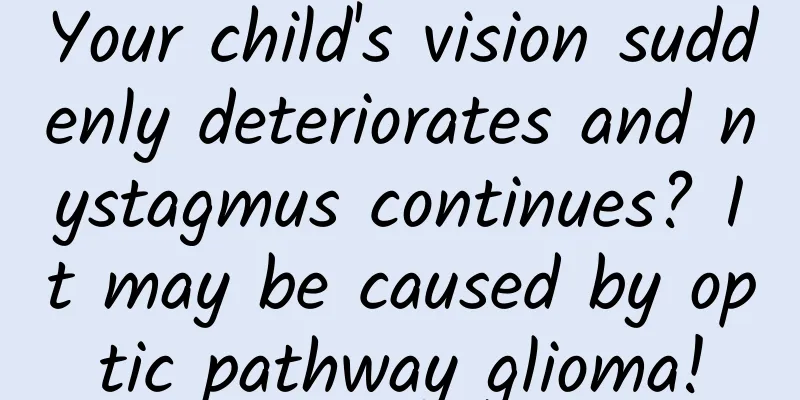Your child's vision suddenly deteriorates and nystagmus continues? It may be caused by optic pathway glioma!

|
Author: Tian Yongji, Chief Physician, Beijing Tiantan Hospital, Capital Medical University Reviewer: Li Jingjing, Chief Physician, Beijing Tiantan Hospital, Capital Medical University In the process of children's growth, vision health is undoubtedly one of the most important issues for every parent. However, when a child's vision suddenly drops sharply or even develops unexplained horizontal nystagmus, parents often feel panic. Today, let’s talk about an “invisible killer” that may be hidden behind children’s vision problems – childhood optic pathway glioma. 1. Understanding of optic pathway glioma in children Optic pathway glioma (OPG) is a type of glioma that originates from the optic nerve and its surrounding structures. This type of tumor may not only occur in the optic nerve itself, but may also involve any part of the optic nerve pathway, including the optic chiasm, optic tracts, and optic radiations. Optic pathway gliomas mainly occur in children, and the high-incidence age group is usually concentrated between 4 and 7 years old. Figure 1 Original copyright image, no permission to reprint The main symptoms of optic pathway gliomas are often decreased vision and visual field defects, which are often a gradual and slow process and are therefore easily overlooked. For younger infants, if rapid horizontal nystagmus occurs, it may be a characteristic manifestation of optic pathway gliomas, which requires special vigilance from parents and doctors. According to statistics from Beijing Tiantan Hospital affiliated to Capital Medical University, the five-year survival rate of optic pathway glioma in children is about 88%, which means that after active and regular treatment, most children can survive for a long time and are expected to return to society and resume normal life. However, for the remaining 12% of children, they may eventually die due to a variety of factors such as severe illness, improper treatment or complications. Therefore, early detection, timely diagnosis and regular treatment of optic pathway glioma are crucial. 2. Classification and characteristics of optic pathway gliomas in children There are two main types of optic pathway gliomas in children, which are classified based on pathological grade and anatomical location. From the perspective of pathological grade, optic pathway gliomas are mostly low-grade malignant tumors. According to the World Health Organization's glioma grading standards, most are grade I pilocytic astrocytomas, and a few are pilomyxoid astrocytomas, which are also currently classified as grade I. Although these tumors have malignant characteristics, they grow relatively slowly and pose relatively little threat to life. From the anatomical point of view, optic pathway gliomas can be divided into three types according to the location of occurrence. Type 1 originates from the intraorbital segment of the optic nerve, and is manifested as decreased vision or protruding eyeballs; Type 2 occurs in the intracranial segment of the optic nerve and before the optic chiasm, and the main symptoms are decreased vision and visual field defects; Type 3 is located after the optic chiasm, including the hypothalamus, optic tracts, optic radiations and other areas, and is often larger in size. The first symptom may be increased intracranial pressure caused by obstructive hydrocephalus, which is manifested as headache, nausea, vomiting and decreased vision. Figure 2 Original copyright image, no permission to reprint It is important to note that although these types differ in anatomical location, there is no strict difference in treatment methods and treatment effects. However, due to the different locations of occurrence, the patient's symptoms may vary. 3. Examination and diagnosis of optic pathway gliomas in children In the process of diagnosing optic pathway glioma in children, neurosurgeons usually use two examination methods: cranial CT and magnetic resonance imaging (MRI). Some parents don't understand why both CT and MRI are needed? In fact, these two examination methods play an irreplaceable role in diagnosis and provide key information for differential diagnosis. MRI examinations, especially sequences that include plain scans and enhanced scans, are particularly critical for the identification of optic pathway gliomas. On T1-weighted images, such tumors usually show signal intensity similar to that of surrounding brain tissue, the so-called isoT1 signal. In T2-weighted images, the signal is also close to isoT2, but a notable feature is that it shows a more obvious and uniform enhancement effect after enhanced scanning. This feature is different from low-grade gliomas in other parts of the brain, which may not be significantly enhanced. This unique MRI manifestation of optic pathway gliomas in children provides doctors with important diagnostic clues. CT examination is indispensable because it can provide some important information to help determine the diagnosis. The most common tumors in the sellar region are craniopharyngioma, germ cell tumor, and optic pathway glioma. Craniopharyngioma often appears as eggshell calcification on CT, which is a circle of calcification surrounding the lesion; while germ cell tumors may appear as high-density shadows on CT images, and patients are often accompanied by symptoms such as polydipsia and polyuria; in contrast, optic pathway glioma appears as isodense or slightly low-density images on CT, and this information is crucial for preoperative differential diagnosis. The sellar region, as an important neuroanatomical concept, is roughly located at the intersection of the horizontal line from the middle of both eyes to the skull and the horizontal line connecting the bilateral temples. It is a common area for optic pathway gliomas and other sellar region tumors. By combining the results of MRI and CT examinations, doctors can make a more accurate diagnosis of optic pathway gliomas in children, while excluding other possible lesions and ensuring the accurate formulation of subsequent treatment plans. |
<<: Cancer is different for men and women? Exploring the gender preference of cancer
Recommend
TCM differentiation of pelvic effusion
There are many treatments for pelvic effusion. Pe...
Staying up late to watch the game will cause vision problems? Pay attention to these habits!
Chasing the top flow Watch live games Paris Olymp...
How are the white sand beaches in the Maldives formed? What is the population of the Maldives?
Maldives is blessed with unique geographical reso...
What to do with dry skin during confinement
Many women do not take care of their skin during ...
What should I do if the fetus has low amniotic fluid?
Amniotic fluid appears in the uterus before the e...
Multiple dark spots on both ovaries
Before I got married, I had very little pubic hai...
What does a pregnant woman's blood test check?
Women need to undergo various examinations during...
How many days of confinement for ectopic pregnancy
Under normal circumstances, pregnancy is a happy ...
Specific situation of fetal movement in 24 weeks of pregnancy
Pregnancy is a very difficult thing for women. Du...
What is the difference between a frog and a toad? Are frogs beneficial insects?
Frogs are beneficial insects, belonging to the ph...
[Someone is diagnosed with cancer every minute] It’s time to take a look at these “weird intestines”!
The large intestine is about 1.5 meters long and ...
Will pubic lice get better on their own without treatment?
Normal people have pubic hair on their genitals, ...
What's wrong with the lower left corner of the stomach?
In daily life, many women will have left abdomina...
Are there follicles in early pregnancy?
The follicle is a form of substance that exists i...









